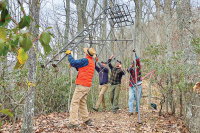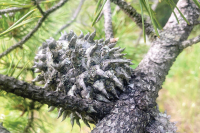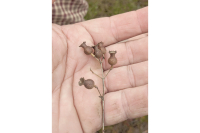Up Moses Creek: This is the world!
 Morning campsites on the Lumber River were full of light and sound. Burt Kornegay photo
Morning campsites on the Lumber River were full of light and sound. Burt Kornegay photo
Like some mountain man who’s happy in his holler, I’m happy to live up Moses Creek. It’s the right place to read, write and ramble in the woods around our house — the 3Rs of retirement for me. But sometimes, days having passed, and wondering how the water flows, I’ll drive down the creek to the Tuckasegee River, where the valley opens up and traffic rushes past, and looking around, I’ll think, “So, this is the world!”
So it was one morning this summer when, canoe on my truck, I drove on down to that part of the world called the Lumber River, in eastern North Carolina. I went to make a river trip. It’s my fourth R of retirement and one thing Moses Creek lacks.
Launching on the Lumber, I followed it through cypress swamps and mossy shade. I camped on the riverbank nights, bathed in the cool water, and, every morning, pushed off to the music of a thousand birds.
I heard piping titmice on the Lumber, trumpeting wrens, white-eyed vireos and parula warblers who ended every trill with an exclamatory “zip!” I heard pulsing cardinals, laughing pileated and churring red-bellied woodpeckers, the “sweet-sweet-sweet” of prothonotary warblers and bluebirds crying “poor me,” while thrushes warbled their wood notes wild, and towhees whistled, “Tow-Wheeee!” Day after day, I glided down a tree-lined concert hall waving my paddle like a baton, while an avian orchestral choir turned the Lumber into song.
Following the Lumber to its confluence with the Little Pee Dee, in South Carolina, I took out there at a landing named “Fork Retch,” then drove home.
I made my living for 30 years as a wilderness canoe guide — and I still love to pull on the paddle for days. But now that I’m in my 70s, I’ve learned that once a river trip is over, and I’ve taken out at some “Fork Retch,” it’s become depressingly easy to sink into a tired, dull lethargy that’s hard to shake. Becky calls it my “zombie” state.
Related Items
So, first morning home from the Lumber, I walked into the woods to hear the dawn chorus. It’s a Moses Creek music that, I hoped, would keep the dread zombie at bay. But what I heard was the spare “chip-burr” of a scarlet tanager, a hooded warbler’s single “tick,” and the downward slur of a wood pewee—dry, detached sounds that only served to heighten the prevailing silence.
Not even an ovenbird sang “Loud,” to quote Robert Frost, although he says they do midsummer. It’s in his sonnet “The Oven Bird.” Ovenbirds made Moses Creek ring in the spring. But in mid-July? I didn’t hear a chirrup.
Back from the silent woods, let down, sensing the zombie at my back, I opened up Frost and, not having heard an ovenbird, listened to the one in his sonnet:
“There is a singer everyone has heard,
Loud, a mid-summer and a mid-wood bird,
Who makes the solid tree trunks sound again.”
Birders call the ovenbird a voice in the woods. And “Loud” is an apt description of it. The bird chants, “Teach! TEach! TEAch! TEACh! TEACH!” Frost’s ovenbird, I discovered, had a lesson to teach me.
I began to hear it in, “Who makes the solid tree trunks sound again.” The line rings boldly, and it comes to life with wordplay. The play is in the “sound.” The word refers to the bird’s chant coming through the trees. But Frost also plays on another meaning of “sound” entirely: solid. After all, if a tree trunk is “solid,” by definition it is “sound,” and if it’s sound, it’s solid. Picking up on Frost’s humor, I heard him tease still one more meaning out of the word — that of health and wholeness. He suggests that the bird’s song is Lazarus-like. It makes “solid tree trunks” hale and whole — “sound again” — as if brought back to life.
From what I know about trees, the power Frost attributes to the ovenbird’s voice is miraculous. To see what I mean, try to make a tree trunk make a sound. Go ahead, yell at one. It will stand there dense, silent. Whack it with a stick and what do you hear? A dull thud.
But Frost’s good humor is the mischief in me, and I think, you CAN make a tree trunk sound, if you whack an “unsound” one, a trunk that’s hollow. Every kid with a stick knows this. Every woodpecker, too. I hear now through the window a pileated woodpecker drumming loudly on a hollow tree, as if to say, “Right on!”
We have two hollow sassafras snags standing side by side in the woods, and when I play my hiking stick between them, they reverberate like tom-toms. Hollow trees are the original drums.
But wood has sleeping in it more than percussive sounds — as all musicians know. In wood they wake a symphony. What is an acoustic guitar without its “sound box”? What are flutes, clarinets and oboes but “woodwinds”? The heart and soul of a piano is its “sounding board.” Ditto for all of the stringed instruments. Take wood away from an orchestra and all that’s left is a triangle, cymbals and brass.
But back to “The Oven Bird.” Following the bold, playful way Frost starts his sonnet, I was surprised to hear what his bird sings about:
“He says that leaves are old, and that for flowers,
Mid-summer is to spring as one to ten.
He says the early petal-fall is past,
When pear and cherry bloom went down in showers
On sunny days a moment overcast . . . ”
The bird’s song of midsummer decline and loss closes with:
“And comes that other fall we name the fall.
He says the highway dust hangs over all.”
The ovenbird’s darkening imagery is deepened by an undertone: “petal-fall . . . fall . . . fall . . . over all.” Full stop.
Frost ends:
“The bird would cease and be as other birds,
But that he knows in singing not to sing.
The question that he frames in all but words
Is what to make of a diminished thing.”
“Other birds” sing in the bloom of spring, but Frost’s ovenbird sings on — into an oven-like season, asking “The question . . . what to make of a diminished thing.” That is, what to make of an old world come to dust.
Reading those lines again, I wondered: Frost is a poet who’s famous for sticking with plain, everyday words; and true to form, he repeatedly uses “He says” in telling what the ovenbird sings about. So, why doesn’t he follow through and have the bird simply “ask” the question? Why say he “frames” it?
Mulling the word over, I saw that “frames” echoes with meanings. To carefully compose something is one: as in, the Founding Fathers “framed” our Constitution. Likewise, the ovenbird “frames” his song. For another, artists “frame” their works to set them off. Just so, the ovenbird “frames” his all-important question.
But it’s with the plain, workaday meaning of “frames” that I heard the line come to life. “Frames” is a building term, used in construction. Who frames things? Well, carpenters do — out of wood. And out of wood skilled workers frame an orchestra of melodious instruments. In his ordinary use of “frames,” I heard Frost rounding the sonnet back to its playful start, where the ovenbird “makes the solid tree trunks sound again,” as if the bird has framed their silent wood into his instrument.
That’s when the poem’s lesson came home. The ovenbird is not on a despairing search for meaning in an old, dusty world. Just as the bird “makes the solid tree trunks sound again,” so, when he “frames” his crucial question, the bird already is making something of that world — his reviving song.
Likewise, in his words about the bird, Frost the bard frames something, too: his own poignant, resonant sonnet. It’s a song “everyone has heard.”
Hearing it, I was back up Moses Creek again and began to write.
(Burt and Becky Kornegay live in Jac kson County. Up Moses Creek comes out the second Wednesday of each month.)













